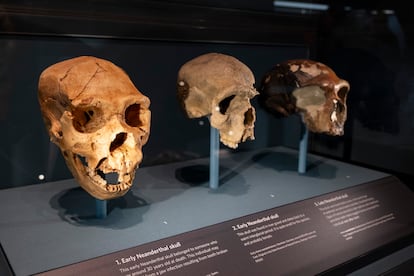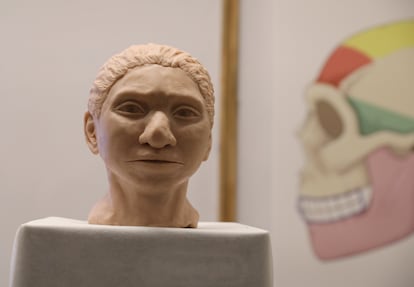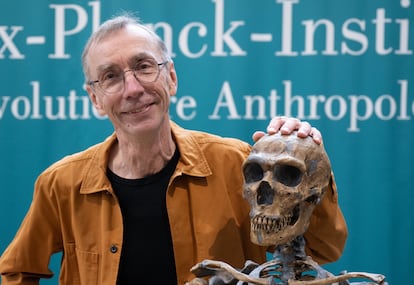More mysterious than Neanderthals, the Denisovans hold the key to humanity
The latest discoveries about the two archaic human species closest to ours reflects constant genetic exchanges


The origin of humanity can be summarized as a long story of hybridization and migrations. The more data we have about the prehistory of our species, thanks above all to the genetic revolution led by Nobel Prize winner Svante Pääbo, the more complex the picture becomes and, at the same time, the simpler: over the millennia, the different species of Homo—to which we ourselves belong—populated the Earth in successive waves from Africa, some successful, others doomed to extinction. The study of fossil DNA has also shown that different species crossed paths on that trip and that these genetic exchanges helped bring to light the only humans that now populate the Earth: Homo sapiens, us.
The latest news about the Neanderthals and the Denisovans — the two archaic human species closest to ours and which became extinct about 40,000 years ago, although many sapiens still carry their genes — have only confirmed this long path, geographical, but also genetic.
It all started when the Swedish scientist Svante Pääbo had the intuition that it was possible to extract and analyze the DNA of species that died thousands of years ago. As with so many scientific advances, at first he had to work alone, secretly carrying out genetic analyses on mummies. We must not forget that no one believed —or funded— the Hungarian researcher Katalin Karikó when she determined to study messenger RNA, a discovery that earned her the Nobel Prize and, no less importantly, helped stop the Covid-19 pandemic.

By sequencing the Neanderthal genome, Pääbo’s team at the Max Planck Institute for Evolutionary Anthropology discovered in 2010 that modern non-African humans share around 3% of genes with this extinct human species. And, by analyzing scattered and small bone remains found in a cave in Siberia, he discovered another human species, closely related to Neanderthals, named after the cave where they were discovered: the Denisovans. It also allowed him to identify the first known hybrid hominin in history, Denisova 11, aka Denny, who died 50,000 years ago at the age of 13, and who had a Neanderthal mother and a Denisovan father. The fact that a hybrid hominin appeared among the very few remains found of this species demonstrates to what extent the exchanges must have been constant.
For most researchers — some still deny the Denisovans the category of distinct species — Neanderthals lived in Europe and Denisovans lived in Asia. Both species disappeared with the arrival of Homo sapiens or, as it seems increasingly clear, they were absorbed by the new humans. To some extent, we are them as well. Science magazine recently published the result of an analysis of three complete Neanderthal genomes: they did not become extinct, but rather were assimilated. In the end, successive waves of Homo sapiens immigration from Africa overwhelmed the Neanderthals until they were unable to remain a separate species and were finally assimilated by sapiens genetics, summarized geneticist Joshua Akey, co-author of the study.

The last Neanderthals were a group of about 2,500 individuals lost in the vastness of prehistoric Europe. Their solitude also represents the history of humanity, which became multiple—at some point, 200,000 years ago, up to eight different human species coexisted on Earth. Now there are only us, the humans that the French paleoanthropologist Jean-Jacques Hublin defines as “the solitary species.”
Information about the Denisovans, just like their remains, are much scarcer, although little by little an exciting map of the evolution—and disappearance—of this species is being drawn. In early July, Science published the discovery of a Denisovan rib about 40,000 years old, the most recent remain found so far (at that time, Homo sapiens had colonized Australia from Africa and was reaching Europe). “That’s extremely recent,” said Bence Viola, a paleoanthropologist at the University of Toronto not involved with the research, in the Science article. “The date puts Denisovans well into the time frame of modern humans in the [wider] region.”
The scholars Silvana Condemi and François Savatier have just published the book L’énigme denisova (The Denisova enigma, not yet translated from the French), which compiles all the known data about these humans, whose genetic heritage is found in populations from places as remote as Australia or the Bataan Peninsula in the Philippines. With their genes they helped modern humans survive in high places such as Tibet, or confront pathogens in rainforests, such as in the Philippines.
This is how the authors describe, for example, what happened over the millennia in the Denisova cave, in the Altai massif, a place where cultures have been crossing since the dawn of time: “The general panorama of human life in Denisova is now clear: for tens of thousands of years, in interglacial times, Neanderthals and Denisovans—two human species closer to each other than to Homo sapiens—frequented the cave and met there. Some researchers even believe that these two species could have founded a common culture in the Altai.”
The vision of that cave in which different species lived together may be too idyllic: in many other sites, such as Cueva del Castillo in Cantabria, in northern Spain, there are signs of both Neanderthal and H. sapien occupations, but they are not simultaneous. By the time one group arrived, the other group had already disappeared. However, genetic exchanges are indisputable—even though they seemed impossible just two decades ago—and there is now certainty that Neanderthal and Denisovan genes have helped modern humanity adapt and survive. But it is also evident that they are no longer there—even though we have inherited their DNA—and that H. sapiens is the only species that populates the Earth. Our arrival meant their extinction, but not without having mixed first. The origin of humanity shown by the paleogenetic revolution has become a story of migrations and admixtures. And, that, without a doubt, offers many readings for our intolerant present.
Sign up for our weekly newsletter to get more English-language news coverage from EL PAÍS USA Edition
Tu suscripción se está usando en otro dispositivo
¿Quieres añadir otro usuario a tu suscripción?
Si continúas leyendo en este dispositivo, no se podrá leer en el otro.
FlechaTu suscripción se está usando en otro dispositivo y solo puedes acceder a EL PAÍS desde un dispositivo a la vez.
Si quieres compartir tu cuenta, cambia tu suscripción a la modalidad Premium, así podrás añadir otro usuario. Cada uno accederá con su propia cuenta de email, lo que os permitirá personalizar vuestra experiencia en EL PAÍS.
¿Tienes una suscripción de empresa? Accede aquí para contratar más cuentas.
En el caso de no saber quién está usando tu cuenta, te recomendamos cambiar tu contraseña aquí.
Si decides continuar compartiendo tu cuenta, este mensaje se mostrará en tu dispositivo y en el de la otra persona que está usando tu cuenta de forma indefinida, afectando a tu experiencia de lectura. Puedes consultar aquí los términos y condiciones de la suscripción digital.
More information
Archived In
Últimas noticias
‘How does it feel to be a failure?’: Elizabeth Berkley’s journey from ‘Showgirls’ ridicule to vindication
The story of the Málaga virus: The code that haunted Google’s cybersecurity center director for 30 years
The impact of Ecuador’s mega-prison: A polluted river, cleared forests and military checkpoints
Corinne Low: ‘I’m more concerned about the female happiness gap than the gender wage gap’
Most viewed
- The low-cost creative revolution: How technology is making art accessible to everyone
- Christian Louboutin: ‘Young people don’t want to be like their parents. And if their parents wear sneakers, they’re going to look for something else’
- All the effects of gentrification in one corner of Mexico’s Colonia Roma
- Liset Menéndez de la Prida, neuroscientist: ‘It’s not normal to constantly seek pleasure; it’s important to be bored, to be calm’
- Christmas loses its festive spirit: ICE fears cast shadow over religious celebrations










































